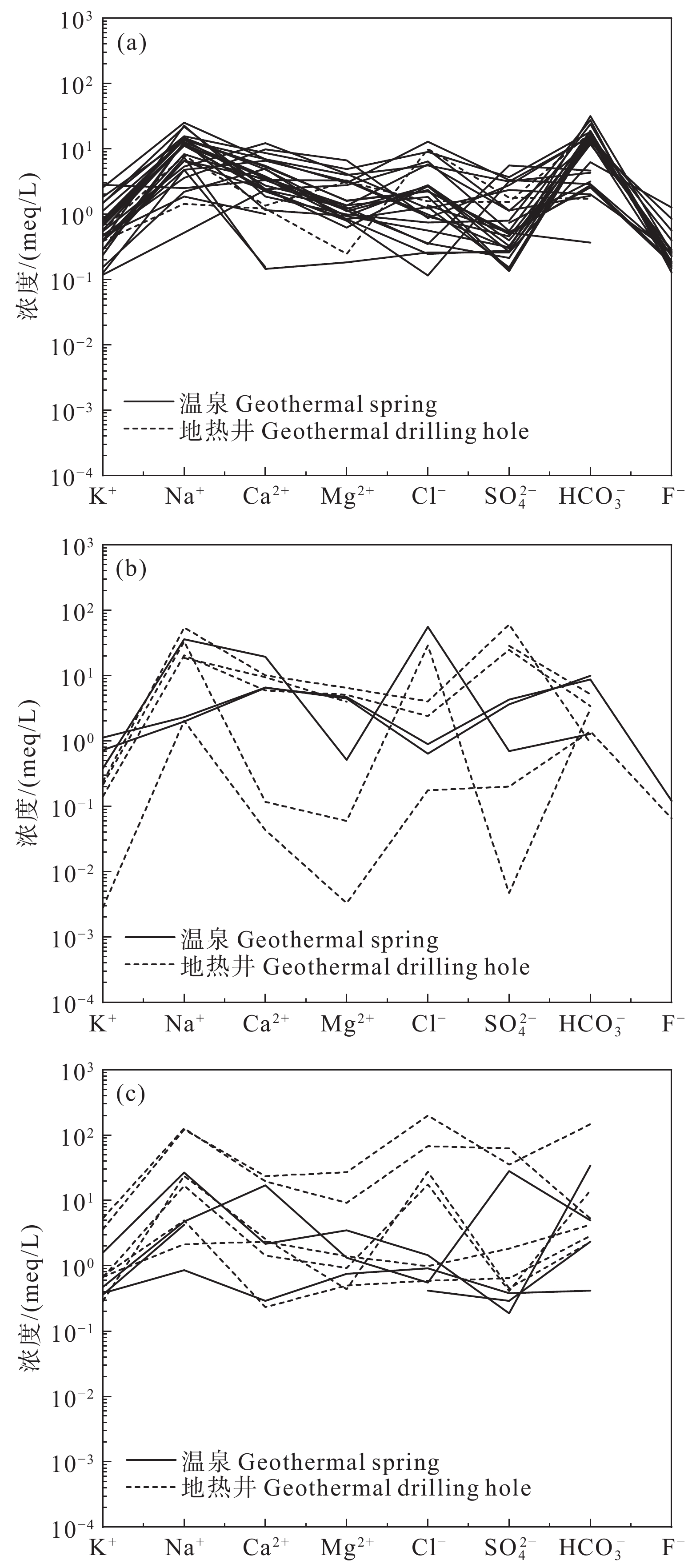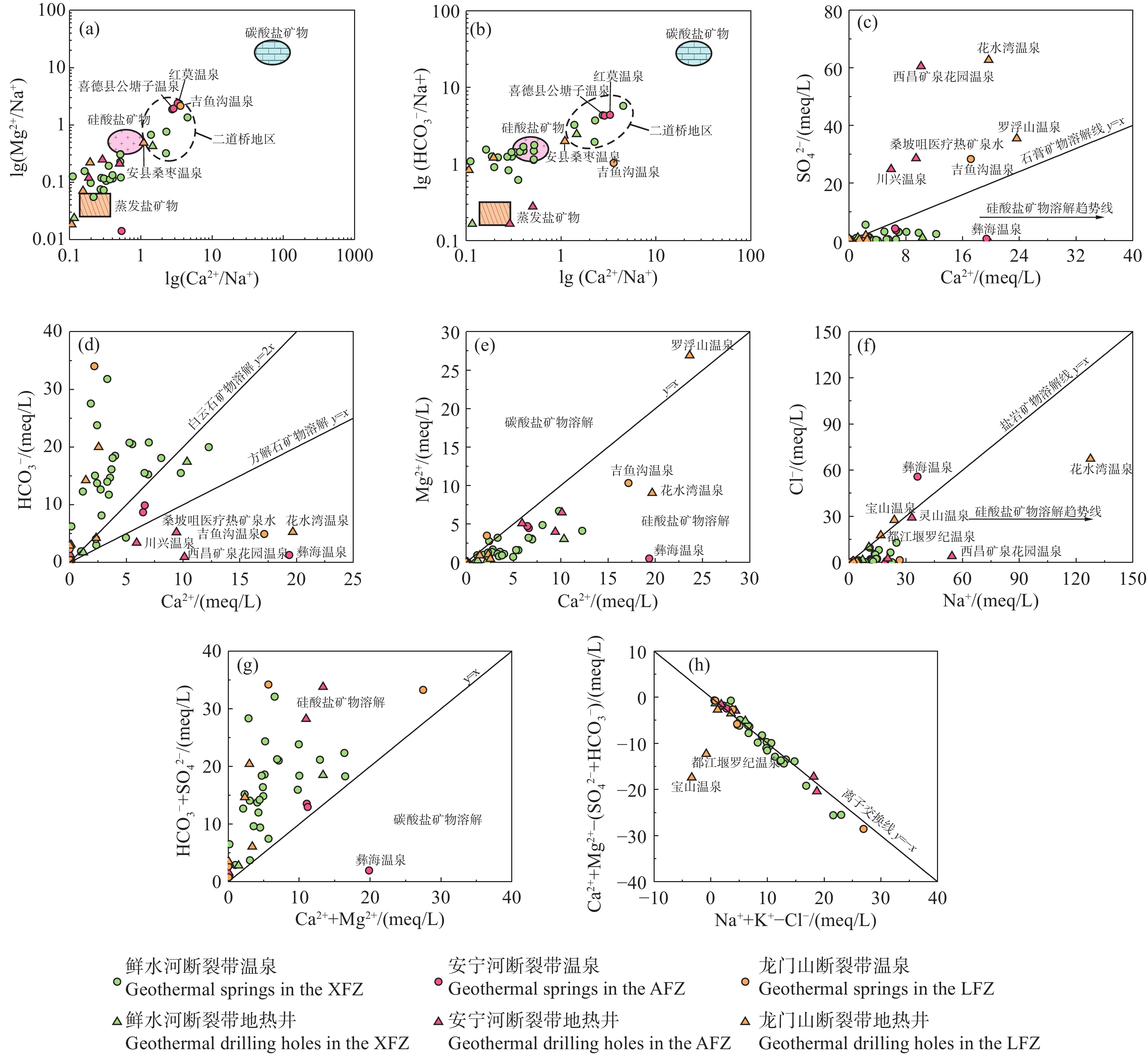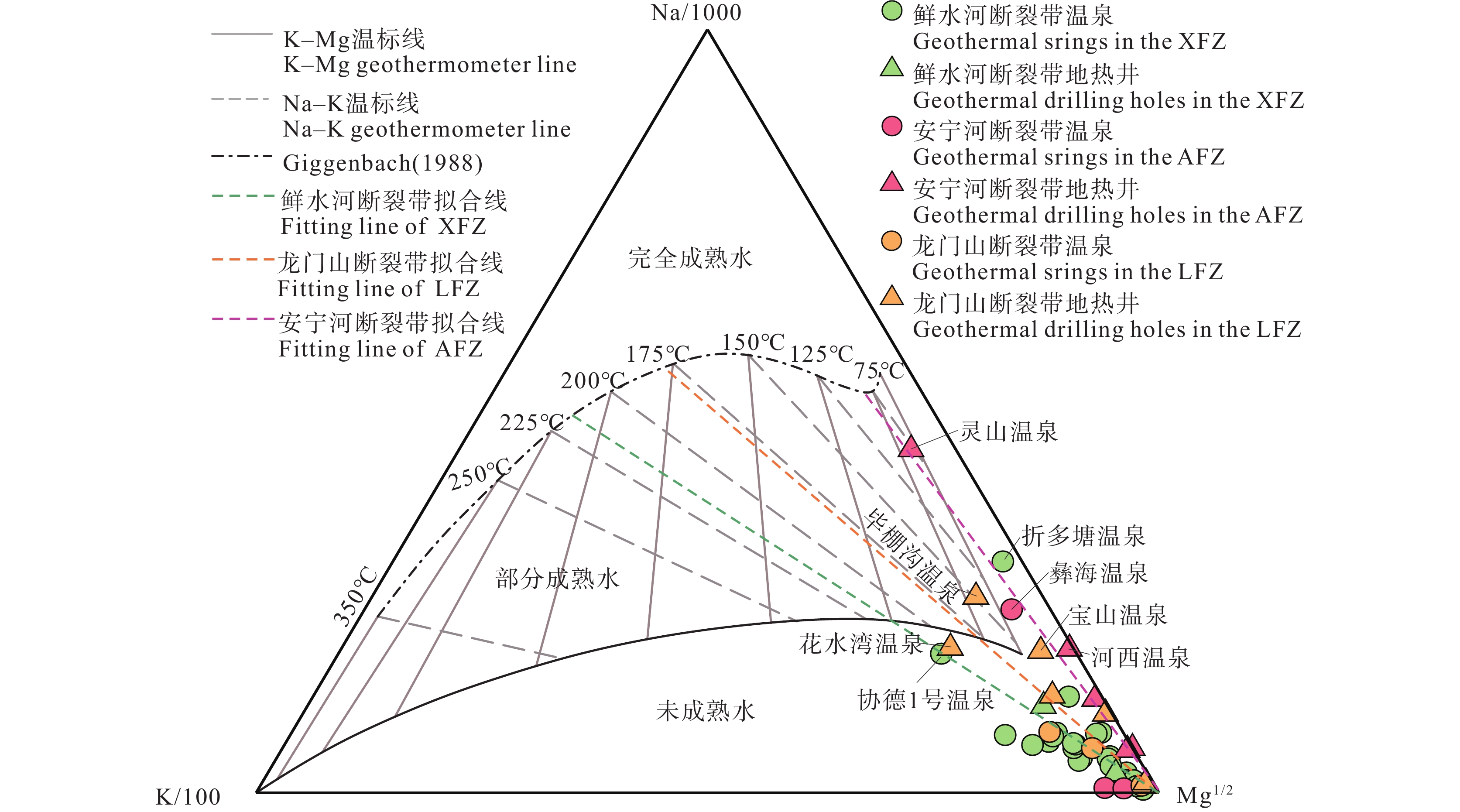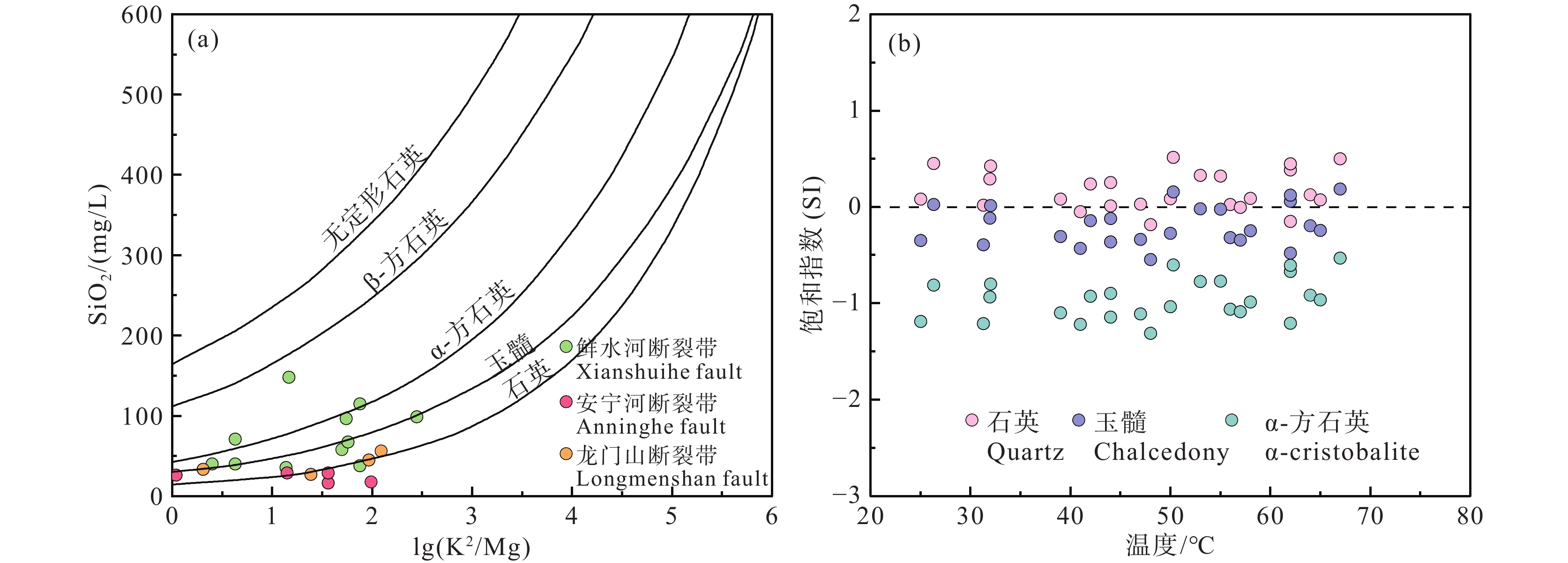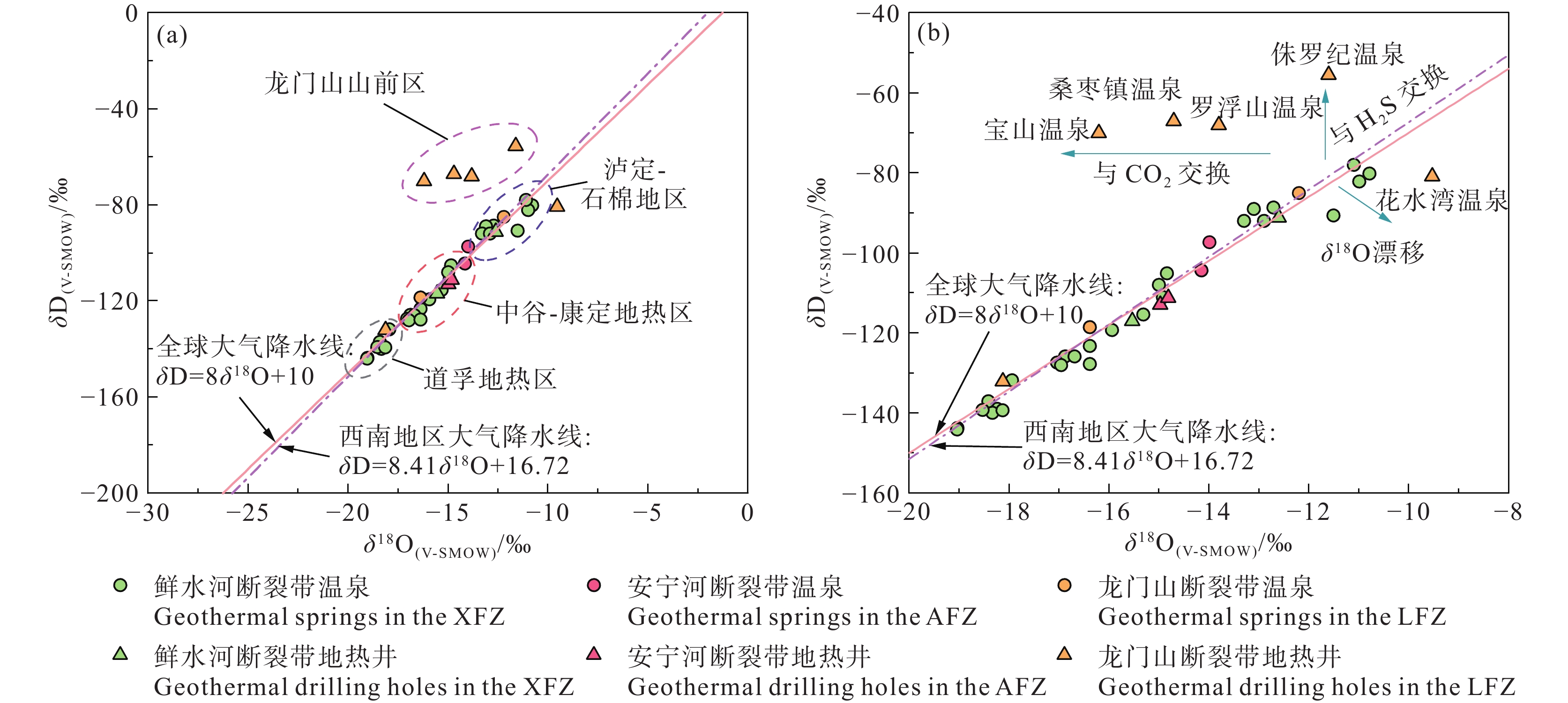Discussion on hydrogeochemical characteristics and genetic model of geothermal waters in Xianshuihe, Anninghe and Longmenshan fault zones in western Sichuan, China
-
摘要:
研究目的 研究川西鲜水河断裂带、安宁河断裂带和龙门山断裂带地热水的水化学特征及成因模式,可为川西地热水资源的合理开发利用提供重要参考依据。
研究方法 本文运用水文地球化学、热储温度计算、氢氧同位素等方法分析了分布在3条断裂带上的48处典型温泉(地热井)的水化学组分、水化学过程、热储温度和深度、热水补给来源等特征,并探讨了其形成模式。
研究结果 结果显示:(1)鲜水河断裂带热水水化学类型以HCO3−Na型为主;龙门山断裂带主要为SO4−Na和Cl−Na型;安宁河断裂带包括HCO3·Cl−Na、HCO3·SO4−Ca·Mg和Cl·SO4−Na型等。(2)3条断裂带地热水组分主要受硅酸盐矿物溶解和离子交换作用控制。(3)鲜水河断裂带热储温度为129.6~210.6℃,深度为2532~4184 m,冷水混入比为66%~82%;安宁河断裂带热储温度为81~121.9℃,深度为2155~3519 m,冷水混入比为52%~95%;龙门山断裂带热储温度为108.2~153℃,深度为3573~5654 m,冷水混入比为68%~89%。(4)3条断裂带的地热水接受大气降雨补给,补给高程分别为鲜水河断裂带2493~5034 m、安宁河断裂带3235~3839 m和龙门山断裂带1628~4574 m。(5)鲜水河断裂带地热水的“δ18O漂移”程度强于安宁河断裂带,龙门山断裂带部分地热水出现“δ18O漂移”和“负向漂移”特征。
结论 基于本次研究得到的3条断裂带地热水成因模式,鲜水河断裂带地热水的开发潜力优于安宁河断裂带、龙门山断裂带,是四川省中高温地热资源开发利用的优势靶区。
Abstract:This paper is the result of geothermal geological survey engineering.
Objective In order to develop and use geothermal water resources in western Sichuan rationally, it is important to study hydrochemical characteristics and genetic models of the geothermal waters spatially linked with the Xianshuihe (XFZ), Anninghe (AFZ), and Longmenshan (LFZ) fault zones.
Methods The methods of hydrogeochemistry, reservoir temperature calculation, hydrogen and oxygen isotopes were used to estimate hydrochemical types, hydrochemical processes, reservoir temperatures and depths, and recharge sources of 48 typical localities of geothermal waters (or geothermal springs or drilling holes) located around these three fault zones, and reconstruct the mode of their formation.
Results (1) Hydrochemically the geothermal waters are dominated by HCO3−Na type in the XFZ, SO4−Na and Cl−Na types in the LFZ and HCO3·Cl−Na, HCO3·SO4−Ca·Mg and Cl·SO4−Na types in the AFZ. (2) The composition of geothermal waters of the three fault zones are mainly controlled by the dissolution of silicate minerals and ion exchange process. (3) The temperatures of the reservoirs, their depths and the cold water mixing ratio are, respectively, 129.6−210.6℃, 2532−4184 meters, and 66%−82% for the XFZ, 81−121.9℃, 2155−3519 meters, and 52%−95% for the AFZ and 108.2−153℃, 3573−5654 meters, and 68%−89% for the LFZ. (4) The geothermal waters in the three fault zones are recharged by meteoric waters derived from elevations at 2493 to 5034 meters in the XFZ, 3235 to 3839 meters in the AFZ, and 1628 to 4574 meters in the LFZ. (5) The degree of the “δ18O drift” of geothermal waters in the XFZ is higher than that in the AFZ, and the geothermal waters in the LFZ exhibit characteristics of “δ18O drift” and “negative drift”.
Conclusions Our results show that among the three perspective areas of the Sichuan Province, the Xianshuihe Fault Zone possesses a higher commercial potential for the exploration and utilization of medium-high temperature geothermal resources compared to the Anninghe and Longmenshan fault zones.
-

-
图 1 研究区的(a)构造位置图和(b)区域地质图(改自Zhang et al., 2017)
Figure 1.
表 1 地热水水化学参数分析与收集结果
Table 1. Analysis and collection results of geothermal water hydrochemical parameters
温泉名称 T/℃ pH TDS K+ Na+ Ca2+ Mg2+ HCO3− SO42− Cl− SiO2 δ18O/‰ δD/‰ 水化学类型 鲜水河
断裂带湾东温泉① 64.0 6.8 1871.3 43.0 310.0 138.3 37.1 930.5 151.2 198.6 75.1 −10.8 −80.2 HCO3−Na·Ca 陈家沟温泉① 62.0 6.7 2822.1 100.0 575.0 139.3 35.9 1269.2 145.6 453.8 127.9 −11.5 −90.7 HCO3−Na 明香温泉① 53.0 6.5 2248.6 58.0 360.0 161.3 58.4 1104.4 147.2 287.2 87.6 −11.0 −82.2 HCO3−Na·Ca 神汤温泉③ 63.5 − − 10.6 125.8 56.3 20.2 497.2 60.5 20.8 − −12 7 −88.6 HCO3−Na·Ca 新兴温泉③ 51.0 − − 9.2 295.6 23.1 11.3 750.4 18.7 98.1 − −14.8 −105.1 HCO3−Na 灌顶温泉③ 85.0 − − 42.2 318.3 54.6 16.2 771.7 53.7 180.2 − −15.3 −115.4 HCO3−Na 中古吊桥1号温泉③ 53.6 − − 25.9 257.6 48.4 7.5 838.8 15.6 73.4 − −16.9 −125.8 HCO3−Na 中古吊桥2号温泉③ 54.8 − − 27.3 260.2 73.7 14.4 985.2 12.7 73.4 − −16.4 −123.3 HCO3−Na 热水塘1号温泉① 50.3 6.9 1009.3 30.0 270.0 71.1 16.4 897.0 6.5 64.9 125.4 −15.9 −119.3 HCO3−Na 热水塘2号温泉① 62.0 6.7 1315.8 32.0 340.0 80.2 13.4 1128.8 5.0 83.3 148.9 −16.7 −125.9 HCO3−Na 折多塘温泉③ 63.0 − − 1.1 161.9 2.9 0.1 381.3 12.5 9.2 − −17.9 −131.9 HCO3−Na 二道桥温泉③ 43.8 − − 21.5 123.5 245.1 49.3 1220.0 112.8 43.3 − −14.9 −111.1 HCO3−Ca 二道桥离垢悦谷温泉② 50.0 6.5 1080.0 22.4 163.0 207.0 36.2 1064.0 50.6 55.4 46.0 −15.5 −117.0 HCO3−Na·Ca 雅拉2号温泉③ 46.0 − − 30.4 315.6 110.2 19.2 1251.0 25.3 78.8 − −17.0 −127.4 HCO3−Na·Ca 雅拉3号温泉③ 38.0 − − 31.4 329.7 105.4 19.4 1266.0 23.8 80.2 − −17.0 −128.0 HCO3−Na 新榆林温泉③ 74.0 − − 54.9 502.5 48.4 33.2 1452.0 26.5 228.3 − −16.4 −127.8 HCO3−Na 协德1号温泉③ 71.9 − − 22.6 274.6 44.5 1.0 918.1 7.3 42.9 − −18 24 −138.9 HCO3−Na 协德2号温泉③ 56.1 − − 81.2 471.3 66.4 38.5 1940.0 14.3 35.3 − −18.3 −139.9 HCO3−Na 葛卡温泉③ 46.0 − − 15.2 109.7 131.7 38.5 945.6 21.9 3.3 − −18.4 −137.1 HCO3−Na·Ca 曲隆沟温泉③ 53.0 − − 12.0 190.5 66.3 13.2 854.1 10.2 10.8 − −19.0 −143.7 HCO3−Na·Ca 龙日沟温泉③ 49.0 − − 11.4 152.1 69.1 9.6 716.8 13.3 8.8 − −18.5 −139.2 HCO3−Na·Ca 龙普沟温泉③ 40.0 − − 11.3 290.2 75.8 11.1 1104.0 14.9 19.8 − −18.1 −139.3 HCO3−Na 麻孜温泉③ 48.0 − − 15.2 521.5 37.2 11.9 1681.0 38.0 2.7 − −19.0 −144. 1 HCO3−Na 小热水温泉④ 26.3 7.9 239.1 4.6 12.0 47.1 8.5 183.1 35.4 − 52.1 − − HCO3−Ca 大热水温泉④ 42.0 7.2 625.0 6.0 50.6 99.2 8.5 262.0 153.0 4.1 52.1 −89.0 −13.1 HCO3·SO4−Na·Ca 鲜水河
断裂带光华村温泉④ 67.0 7.1 905.0 15.0 150.0 46.1 15.2 248.0 268.0 12.4 192.0 −92.0 −13.3 HCO3·SO4−Na 幸福村温泉④ 55.0 6.9 1561.0 18.5 82.0 196.0 80.3 946.0 133.0 31.0 92.3 −78.0 −11.1 HCO3−Ca·Mg 新棉镇温泉④ 58.0 7.6 850.0 18.0 250.0 20.0 − 117.0 48.5 341.0 59.8 −92.0 −12.9 HCO3·Cl−Na 公益海温泉群④ 56.0 9.5 369.0 4.9 110.0 3.0 − 22.0 24.9 48.4 113.0 −108.0 −15.0 Cl−Na 新棉镇地热井④ 57.0 8.2 777.0 15.0 240.0 24.2 3.0 105.6 51.4 354.0 49.0 −91.2 −12.6 Cl−Na 安宁河
断裂带灵山温泉② 31.3 8.3 1970.0 8.4 763.0 2.3 0.7 189.0 0.2 1030.0 23.0 −113.0 −15.0 Cl−Na 彝海温泉② 25.0 7.5 3300.0 14.9 831.0 387.0 6.2 78.2 33.4 1980.0 21.0 −104.4 −14.2 Cl−Na Ca 喜德县公塘子温泉③ 47.0 6.8 810.8 44.0 53.0 132.3 53.5 604.1 174.4 22.7 37.1 − − HCO3−Ca·Mg 红莫温泉⑤ 62.0 6.9 815.1 28.4 45.4 129.4 56.6 530.6 205.0 31.7 37.4 −14.0 −97.3 HCO3−Ca·Mg 西昌矿泉花园温泉⑥ 39.0 8.1 4641.8 9.2 1250.0 202.4 77.8 56.5 2904.0 142.5 33.5 − − SO4−Na 桑坡咀医疗热矿泉水⑥ 41.0 7.4 2240.5 − 430.0 188.4 47.4 317.3 1372.0 − 25.9 − − HCO3·SO4−Na·Ca 川兴温泉⑥ 44.0 8.2 2062.2 5.5 470.0 118.2 60.8 207.5 1192.0 85.8 34.1 − − SO4−Na 河西温泉③ 37.3 − − 0.1 46.8 0.9 0.0 85.4 9.6 6.2 − −14.8 −111.3 HCO3−Na 龙门山
断裂带毕棚沟温泉② 65.0 8.1 258.0 2.7 94.2 0.5 0.1 176.5 31.1 21.1 73.0 −18.1 −132.1 HCO3−Na 古尔沟温泉② 48.0 9.1 68.0 1.5 19.7 0.6 0.1 24.5 18.2 3.2 35.0 −16.4 −118.6 HCO3·SO4−Na 观音庙温泉② 32.0 7.5 2949.0 62.4 615.0 43.5 41.7 2075.0 9.0 49.9 58.1 − − HCO3−Na 吉鱼沟温泉② 31.9 7.2 2150.0 15.9 110.0 343.0 124.0 301.6 1360.0 19.7 43.0 −12.2 −85.1 HCO3·SO4− Ca·Mg 甲石口温泉② 44.0 9.3 384.0 1.4 97.9 − − 143.0 14.0 14.7 88.8 − − HCO3−Na 安县桑枣镇温泉⑦ 24.5 7.9 360.0 2.6 49.1 46.8 12.5 258.6 88.1 34.9 − −14.7 −67.1 HCO3−Na·Ca 罗浮山温泉⑦ 26.0 8.0 16990.0 119.5 2800.5 472.6 322.9 8977.8 1701.6 7088.7 − −13.8 −68.1 HCO3·Cl−Na 龙门山镇宝山温泉⑦ 39.3 8.1 2220.0 11.3 549.9 51.1 5.3 1220.2 19.4 977.8 − −16.2 −70.1 HCO3·Cl−Na 都江堰侏罗纪温泉⑦ 26.5 8.5 1500.0 2.6 384.3 28.7 10.8 868.3 19.7 623.7 − −11.6 −55.5 HCO3·Cl−Na 花水湾温泉⑦ 63.6 7.7 9240.0 208.9 2936.0 393.3 108.2 322.1 3007.7 2390.3 − −9.5 −80.9 SO4·Cl−Na 注: ①为2014年采样;②为2020年10月和2021年6月采样;③数据来源于张磊等(2021);④为2017年采样;⑤数据来源于袁建飞等(2017);⑥数据来源于王贵玲(2018);⑦数据来源于颜玉聪等(2021);“−”表示该点未采样或未收集到数据。 表 2 地热水热储温度、冷水混合比例以及循环深度的估算结果
Table 2. Estimation results of the reservoir temperature, cold water mixing ratio and circulation depth of geothermal water
热储温度计算结果/℃ 冷水混合比例 循环深度/m SiO2地热温标 Na–K–Mg 硅焓混合模型 鲜水河断裂带 98~177.2(a=129.6) 200~225 150~275(a=210.6) 66%~82% 2532~4184 安宁河断裂带 70.6~88.8(a=81) 100~125 100~140(a=121.9) 52%~95% 2155~3519 龙门山断裂带 85.9~130.7(a=108.2) 150~175 102~177(a=153) 68%~89% 3573~5654 注:“a”表示平均值。 表 3 三条断裂带地热水补给高程的计算结果
Table 3. Calculation results of the recharge elevation of geothermal water in the three major fault zones
构造位置 δ18O计算的补给高程 δD计算的补给高程 δ18O/‰ H/m δD/‰ H/m 鲜水河断裂带 −10.79~−19.04 2226~4888 −78~−144.07 2493~5034 安宁河断裂带 −13.99~−14.97 3259~3575 −97.3~−113 3235~3839 龙门山断裂带 −9.53~−18.12 1820~4591 −55.5~−132.1 1628~4574 -
[1] Asta M P, Gimeno M J, Luis F A, Javier G, Patricia A, Pilar L. 2012. Hydrochemistry and geothermometrical modeling of low−temperature Panticosa geothermal system (Spain)[J]. Journal of Volcanology & Geothermal Research, 235: 84−95.
[2] Allen C R, Luo Zhuoli, Qian Hong, Wen Xueze, Zhou Hhuawei, Huang Weishi. 1991. Field–study of a highly–active fault zone–the Xianshuihe fault of southwestern China[J]. Geological Society of America Bulletin, 103(9): 1178−1199. doi: 10.1130/0016-7606(1991)103<1178:FSOAHA>2.3.CO;2
[3] Arnorsson S, Andresdottir A. 1985. The use of mixing models and chemical geothermometers for estimating underground temperatures in geothermal systems[J]. Journal of Volcanology and Geothermal Research, 23(3/4): 299−335.
[4] Arnorsson S. 1995. Processes controlling the distribution of boron and chlorine in natural–waters in iceland[J]. Geochimica et Cosmochimica Acta, 59(20): 4125−4146. doi: 10.1016/0016-7037(95)00278-8
[5] Blasch K W, Bryson J R, 2007. Distinguishing sources of ground water recharge by using δ2H and δ18O[J]. Ground Water, 45(3): 294–308.
[6] Capaccioni B, Vaselli O, Tassi F, Santo A P, Delgado H A. 2011. Hydrogeochemistry of the thermal waters from the Sciacca Geothermal Field (Sicily, southern Italy)[J]. Journal of Hydrology, 396(3/4): 292−301.
[7] Craig J, Absar A, Bhat G, Cadel G, Hafiz M, Hakhoo N, Kashkari R, Moore J, Ricchiuto T E, Thurow J. 2013. Hot springs and the geothermal energy potential of Jammu & Kashmir state, N. W. Himalaya, India[J]. Earth–Science Reviews, 126: 156−177.
[8] Chandrajith R, Barth J A C, Subasinghe N D, Merten D, Dissanayake C B. 2013. Geochemical and isotope characterization of geothermal spring waters in Sri Lanka: Evidence for steeper than expected geothermal gradients[J]. Journal of Hydrology Amsterdam, 476: 360−369. doi: 10.1016/j.jhydrol.2012.11.004
[9] Cheng Yuanzhi, Pang Zhonghe, Kong Yanlong, Chen Xiaobin, Wang Guangjie. 2022. Imaging the heat source of the Kangding high–temperature geothermal system on the Xianshuihe fault by magnetotelluric survey[J]. Geothermics, 102386.
[10] Chen Zhi. 2014. Hydrogeochemistry of thehot springs in Western Sichuan Province, Southwestern China after the WenchuanMs8.0earthquake[D]. Hefei: University of Science and Technology of China, 1–98 (in Chinese with English abstract).
[11] Craig H. 1961. Isotopic variations in meteoric waters[J]. Science, 133(346): 1702−1703.
[12] Ding Weipin, Xie Caifu, Huang Cheng, Zhang Bin, Xin Zhuo, Zhan Huasi, Zheng Lilong, Kong Fanquan, Wang Hongbing, Huang Fulin. 2023. Sources of ore–forming lead–zinc in the Permian carbonate rock of in Sichuan–Yunnan–Guizhou area: S, Pb, C, H and O Isotope constraints–A case of Taipingzi lead–zinc deposit in Xundian county, Yunnan Provinces[J]. Geology in China, 49(6): 1845−1861 (in Chinese with English abstract).
[13] Domra K J, DjongyangN, Danwe R, Njandjock N P, Abdouramani D. 2015. A review of geophysical methods for geothermal exploration[J]. Renewable & Sustainable Energy Reviews, 44(Apr.): 87−95.
[14] Fournier R O. 1977. Chemical geothermometers and mixing models for geothermal systems[J]. Geothermics, 5(1/4): 41−50.
[15] Gaillardet J, Dupré B, Louvat P, Allegre C J. 1999. Global silicateweathering and CO2 consumption rates deduced from the chemistry oflarge rivers[J]. Chemical Geology, 159(1): 3−30.
[16] Giggenbach W F. 1988. Geothermal solute equilibria. Derivation of Na–K–Mg–Ca geoindicators[J]. Geochimica et Cosmochimica Acta, 52(12): 2749−2765. doi: 10.1016/0016-7037(88)90143-3
[17] Giggenbach W F, Glover R B. 1992. Tectonic regime and major processes governing the chemistry of water and gas discharges from the rotorua geothermal field, New Zealand[J]. Geothermics, 21(1): 121−140.
[18] Guo Qinghai, Wang Yanxin. 2012. Geochemistry of hot springs in the Tengchong hydrothermal areas, southwestern China[J]. Journal of Volcanology and Geothermal Research, 215: 61−73.
[19] Guo Jing, Tang Fawei, Guan Hui, Zhao Haihua, Zhao Xiaoyun, Dan Zengguo Jie, Du Bingrui. 2023. The structure–thermal coupling model of the high temperaturegeothermal system in Rujiao on the Tibet Plateau[J]. Geology in China, 50(6): 1621−1631 (in Chinese with English abstract).
[20] Haehnlein S, Bayer P, Ferguson G, Blum P. 2013. Sustainability and policy for the thermal use of shallow geothermal energy[J]. Energy Policy, 59: 914−925. doi: 10.1016/j.enpol.2013.04.040
[21] Hao Ming, Wang Qingliang, Shen Zhengkang, Cui Duxin, Ji Lingyun, Li Yuhang, Qin Shanlan. 2014. Present day crustal vertical movement inferred from precise leveling data in eastern margin of Tibetan Plateau[J]. Tectonophysics, 632(C): 281−292.
[22] Hu Zexiang, Zhao Xueqin, Li Song, Li Yajun, Wang Yuyu, Yang Luo. 2022. Geothermal hydrogeochemical characteristics and genetic analysis of the Seda–Songpan fault block[J]. Geoscience, 36(2): 484−493 (in Chinese with English abstract).
[23] Kong Yanlong, Wang Ke, Li Jie, Pang Zhonghe. 2019. Stable isotopes of precipitation in China: A consideration of moisture sources[J]. Water, 11(6): 1239.
[24] Ke Bin. 2014. An Analysis on Genetic Model and Development Prospects of Jiyu Hot Spring in Maoxian County, Sichuan Province[D]. Chengdu: Chengdu University of Technology, 1–70(in Chinese with English abstract).
[25] Li Jiexiang, Yang Guang, Sagoe G, Li Yilian. 2018. Major hydrogeochemical processes controlling the composition of geothermal waters in the Kangding geothermal field, western Sichuan Province[J]. Geothermics, 75: 154−163. doi: 10.1016/j.geothermics.2018.04.008
[26] Li Jiexiang, Sagoe G, Yang Guang, Liu Danqing, Li Yilian. 2019. The application of geochemistry to bicarbonate thermal springs with high reservoir temperature: A case study of the Batang geothermal field, western Sichuan Province, China[J]. Journal of Volcanology and Geothermal Research, 371: 20−31. doi: 10.1016/j.jvolgeores.2018.12.005
[27] Li Xiao, Huang Xun, Liao Xin, Zhang Yunhui. 2020. Hydrogeochemical characteristics and conceptual model of the geothermal waters in the xianshuihe fault zone, southwestern China[J]. International Journal of Environmental Research and Public Health, 17(2): 500−514. doi: 10.3390/ijerph17020500
[28] Li Xiao, Wang Jinjin, Huang Xun, Yu Zhongyou. 2018. Chemical and isotopic characteristics of hot water in the Kangding–Daofu section of Xianshuihe fault zone, Sichuan, China[J]. Journal of Chengdu University of Technology(Science & Technology Edition), 45(6): 733–745(in Chinese with English abstract).
[29] Liang Shiming, Gan Weijun, Shen Chuanzheng, Xiao Genru, Liu Jing, Chen Weitao, Ding Xiaoguang, Zhou Deming. 2013. Three–dimensional velocity field of present–day crustal motion of the Tibetan Plateau derived from GPS measurements[J]. Journal of Geophysical Research–Planets, 118(10): 5722−5732.
[30] Liu Wei, Guan Lufeng, Liu Yi, Xie Xiangang, Zhang Maoliang, Chen Biying, Xu Sheng, Sano Y. 2022. Fluid geochemistry and geothermal anomaly along the Yushu–Ganzi–Xianshuihe fault system, eastern Tibetan Plateau: Implications for regional seismic activity[J]. Journal of Hydrology, 607: 127554.
[31] Lu Lianghua, Pang Zhonghe, Kong Yanlong, Guo Qi, Wang Yingchun, Xu Chenghua, Gu Wen, Zhou Lingling, Yu Dandan. 2018. Geochemical and isotopic evidence on the recharge and circulation of geothermal water in the Tangshan geothermal system near Nanjing, China: Implications for sustainable development[J]. Hydrogeology Journal, 26(5): 1705−1719. doi: 10.1007/s10040-018-1721-6
[32] Luo Ji, Pang Zhonghe, Kong Yankong, Wang Yingchun. 2017. Geothermal potential evaluation and development prioritization based on geochemistry of geothermal waters from Kangding area, western Sichuan, China[J]. Environmental Earth Sciences, 76(9): 343. doi: 10.1007/s12665-017-6659-9
[33] Luo Lailin. 1994. Inquisition of the distribution and cause of the hot springs in western Sichuan[J]. Journal of Chongqing Normal University(Natural Science), 11(2): 39−47 (in Chinese with English abstract).
[34] Long Sisheng, Zhao Zhu. 2000. Characteristics of the seismic source stress field in the intersection region of Xianshuihe, Longmenshan and Anninghe faults[J]. Acta Seismologica Sinica, 22(5): 457−464, 560 (in Chinese with English abstract).
[35] Mongillo M A, Axelsson G. 2010. Preface to geothermics special issue on sustainable geothermal utilization[J]. Geothermics, 39(4): 279−282. doi: 10.1016/j.geothermics.2010.09.011
[36] Ma Zhiyuan, Wu Min, Zheng Huiju, Xu Yong, Meng Yang, Dang Shusheng. 2018. A re–recognition of the main controlling factors for δ18O enrichment in deep geothermal water of Guanzhong basin[J]. Geological Bulletin of China, (Z1): 487−495 (in Chinese with English abstract).
[37] Mo Xuanxue. 2009. A review of genesis study on magmatic rocks of the Qinghai–Tibet Plateau: Achievements and remaining problems[J]. Geological Bulletin of China, 28(12): 1693−1703 (in Chinese with English abstract).
[38] Mo Xuanxue. 2010. A review and prospect of geological researches on the Qinghai–Tibet Plateau[J]. Geology in China, 37(4): 841−853 (in Chinese with English abstract).
[39] Nukman M, Hochstein M P. 2019. The sipoholon geothermal field and adjacent geothermal systems along the north–central sumatra fault belt, indonesia: Reviews on geochemistry, tectonics, and natural heat loss[J]. Journal of Asian Earth Sciences, 170: 316–328.
[40] Pu Benjin. 1981. Hot water physicochemical characteristics and fault activity of the Xianshuihe fault and Moxi fault[J]. Earthquake Research in Sichuan, (4): 22−23 (in Chinese with English abstract).
[41] Ran Yongkang, Cheng Jianwu, Gong Huiling, Chen Lichun. 2008. Late quaternary geomorphic deformation and displacement rates of the Anninghe fault around Zimakua[J]. Seismology and Geology, 30(1): 86−98 (in Chinese with English abstract).
[42] Shaw A M, Hauri E H, Fischer T P, Hilton D R, Kelley K A. 2008. Hydrogen isotopes in Mariana arc melt inclusions: Implications for subduction dehydration and the deep–earth water cycle[J]. Earth and Planetary Science Letters, 275(1/2): 138−145. doi: 10.1016/j.jpgl.2008.08.015
[43] Ta Mingming, Zhou Xun, Guo Juan, Wang Yuan, Wang Xinyun, Xu Yanqiu. 2019. Hydrogeochemical characteristics and formation of the hot springs occurring in the plunging ends of an anticline in Chongqing, eastern Sichuan basin, China[J]. Environmental Earth Sciences, 78(15): 468. doi: 10.1007/s12665-019-8486-7
[44] Tang Xianchun, Zhang Jian, Pang Zhonghe, Hu Shengbiao, Wu Ying, Bao Shujing. 2017a. Distribution and genesis of the eastern Tibetan Plateau geothermal belt, western China[J]. Environmental Earth Sciences, 76(1): 31. doi: 10.1007/s12665-016-6342-6
[45] Tang Xianchun, Zhang Jian, Pang Zhonghe, Hu Shengbiao, Tian Jiao, Bao Shujing. 2017b. The eastern Tibetan Plateau geothermal belt, western China: Geology, geophysics, genesis, and hydrothermal system[J]. Tectonophysics, 717: 433−448. doi: 10.1016/j.tecto.2017.08.035
[46] Wang Chenguang, Zheng Mianping. 2019. Hydrochemical characteristics and evolution of hot fluids in the Gudui geothermal field in Comei county, Himalayas[J]. Geothermics, 81(SEP.): 243−258.
[47] Wang Guiling. 2018. Geothermal Records of China, Southwest Volume 1[M]. Beijing: Science Press, 1−278(in Chinese).
[48] Wang Hu, Ran Yongkang, Chen Lichun, Liang Mingjian, Gao Shuaipo, Li Yanbao, Xu Liangxin. 2018. Determination of slip rate on the southern segment of the Anninghe fault[J]. Seismology and Geology, 40(5): 967−979 (in Chinese with English abstract).
[49] Wang Xinwei, Wang Tinghao, Li Haiquan, Zhang Xuan, Luo Lu, Liu Huiying, Wang Simin, Xiang Caifu. 2022. Evolution of karst geothermal system and its geothermal resource potential in Taiyuan Basin[J]. Geology in China, 49(3): 716−731 (in Chinese with English abstract).
[50] Xu Hong, Zhang Haiyang, Zhang Derun, Lu Shushen, Lu Jianzhong, Wang Xiuqi, Zhang Weiwei. 2016. The deep faults separating land and sea basins in lower Yangtze region and their tectonic significance[J]. Marine Geology Frontiers, 32(3): 16−23 (in Chinese with English abstract).
[51] Xu Sheng, Guan Lufeng, Zhang Maoliang, Zhong Jun, Liu Wei, Xie Xiangang, Liu Congqiang, Takahata N, Sano Y. 2022. Degassing of deep–sourced CO2 from Xianshuihe–Anninghe faultzones in the eastern Tibetan Plateau[J]. Science China Earth Sciences, 52(2): 291−308 (in Chinese with English abstract).
[52] Xu Xiwei, Zhang Peizhen, Wen Xueze, Qin Zunli, Chen Guihua, Zhu Ailian. 2005. Features of active tectonics and recurrence behaviors of strong earthquakes in the western Sichuan Province and its adjacent regions[J]. Seismology and Geolog, 27(3): 446−461 (in Chinese with English abstract).
[53] Yang Wencai, Jin Sheng, Zhang Luolei, Qu Chen, Hu Xiangyun, Wei Wenbo, Yu Changqing, Yu Peng. 2020. The three–dimensional resistivity structures of the lithosphere beneath the Qinghai–Tibet Plateau[J]. Chinese Journal of Geophysics, 63(3): 817−827.
[54] Yi Lei, Qi Jihong, Li Xiao, Xu Mo, Zhang Xiaoyu, Zhang Qiang, Tang Yige. 2021. Geochemical characteristics and genesis of the high–temperature geothermal systems in the north section of the Sanjiang Orogenic belt in southeast Tibetan Plateau[J]. Journal of Volcanology and Geothermal Research, 414: 107244.
[55] Yu Jinsheng, Zhang Hongbin, Yu Fuji, Liu Deping. 1984. Oxygen and hydrogen isotopic compositions of meteoric waters in the eastern part of Xizang[J]. Geochemistry, 3(2): 93−101. doi: 10.1007/BF03179285
[56] Yuan Jianfei, Deng Guoshi, Xu Fen, Tang Yeqi, Li Pengyue. 2017. Hydrogeochemical characteristics of groundwater in the Xide geothermal field, southwest Sichuan, China[J]. Geoscience, 31(1): 200−208 (in Chinese with English abstract).
[57] Yuan Xingcheng, Zhang Yunhui, Wang Ying, Huang Xun, Sun Minglu, Lü Guosen. 2023. Geothermal water chemical characteristics and scaling analysis of Xianshuihe fault zone[J]. Sedimentary Geology and Tethyan Geology, 43(2): 1−16 (in Chinese with English abstract).
[58] Yan Yucong, Liu Fengli, Guo Lishuang, Zhou Xiaocheng, Ouyang Shupei, Li Jingchao, Wang Wanli. 2021. Hydrogeochemical characteristics of the hot springs in the Longmenshan fault zone[J]. Journal of Seismological Research, 44(2): 170−184 (in Chinese with English abstract).
[59] Zhou Peng, Sun Minglu, Zhang Yunhui, Rong Feng, Da Wa, Wan Zhongyan, Liu Gongxi, Peng Qinghua, Hu Huashan, Dan Zeng, Liu Zhenfeng. 2023. Hydrogeochemical characteristics and genetic mechanism of the Molu geothermal springs in the Longzi County, Southern Tibet[J]. Sedimentary Geology and Tethyan Geology, 43(2): 1−19 (in Chinese with English abstract).
[60] Zhou Yu, Zhou Xiong, Zhang Yi, Qin Zhipeng, Jia Zhiquan, Liang Bing. 2022. Geochemistry, zircon geochronology and Lu–Hf isotopiccharacteristics of the Sudi monzogranite in the Western Sichuan: Implications for tectonic setting of the Songpan–Ganze terrane[J]. Geology in China, 49(6): 1984−2001 (in Chinese with English abstract).
[61] Zhang Peizhen. 2013. A review on active tectonics and deep crustal processes of the western Sichuan region, eastern margin of the Tibetan Plateau[J]. Tectonophysics, 584: 7−22. doi: 10.1016/j.tecto.2012.02.021
[62] Zhang Wei, Wang Guiling, Xing Linxiao, Li Tingxin, Zhao Jiayi. 2019. Geochemical response of deep geothermal processes in the Litang region, Western Sichuan[J]. Energy Exploration & Exploitation, 37(2): 626−645.
[63] Zhang Yuanze, Replumaz A, Leloup P H, Wang Guocan, Bernet M, van der Beek P, Paquette J L, Chevalier M L. 2017. Cooling history of the Gongga batholith: Implications for the Xianshuihe fault and Miocene kinematics of SE Tibet[J]. Earth and Planetary Science Letters, 465: 1−15. doi: 10.1016/j.jpgl.2017.02.025
[64] Zhang Yunhui. 2018. Research on Genesis and Development of the Geothermal System in the Kangding–Moxi Segment of the Xianshuihe Fault[D]. Chengdu: Chengdu University of Technology, 1–182(in Chinese with English abstract).
[65] Zhang Yunhui, Li Xiao, Xu Mo, Duo Ji, Wu Xiyong, Xiao Yong, Huang Xun. 2021. Hydrogeochemical characteristics of geothermal waters in the Daofu area of the Xianshuihe geothermal belt[J]. Safety and Environmental Engineering, 28(3): 42−51 (in Chinese with English abstract).
[66] Zhang Lei, Guo Lishuang, Liu Shuwen, Yang Yao, Shi Deyang. 2021. Characteristics of hydrogen and oxygen stable isotopes of hot springs in Xianshuihe–Anninghe fault zone, Sichuan Province, China[J]. Acta Petrologica Sinica, 37(2): 589−598 (in Chinese with English abstract). doi: 10.18654/1000-0569/2021.02.16
[67] Zhang Xigen. 1988. Application of isotope geochemistry in geothermal exploration[J]. Hydrogeology and Engineering Geology, (1): 28−31 (in Chinese with English abstract).
[68] Zhang Xu, Zhang Wen, Lü Guosen, Yu Zhongyou, Dai Qian. 2023. Geochemical, geophysical genesis of the Ranggu Geothermal Spring in Aba Prefecture, Western Sichuan: Evidence from hydrogeochemical and geophysical exploration[J]. Sedimentary Geology and Tethyan Geology, 43(2): 1−16 (in Chinese with English abstract).
[69] Zhao Qingsheng. 1984. The hydrogeochemical characteristics and forming model of hot water in the Xian Shui–he fracture zone[J]. Advanced Engineering Sciences, (2): 77−88 (in Chinese with English abstract).
[70] Zhao Qingsheng. 1987. The hydrothermal system of Xide geothermal field[J]. Advanced Engineering Sciences, (2): 123−130 (in Chinese with English abstract).
[71] 陈志. 2014. 汶川地震后川西地区温泉水地球化学研究[D]. 合肥: 中国科学技术大学, 1−98.
[72] 丁伟品, 谢财富, 黄诚, 张斌, 辛卓, 詹华思, 郑立龙, 孔凡全, 王红兵, 黄福林. 2022. 川滇黔地区二叠系碳酸盐岩中铅锌成矿物质来源: C−H−O−S−Pb同位素制约—以云南寻甸太平子铅锌矿为例[J]. 中国地质, 49(6): 1845−1861. doi: 10.12029/gc20220611
[73] 郭镜, 唐发伟, 官辉, 赵海华, 赵小云, 旦增国杰, 杜炳锐. 2023. 青藏高原如角高温地热系统构造—热耦合成热模式[J]. 中国地质, 50(6): 1621−1631.
[74] 胡泽祥, 赵学钦, 李松, 李亚军, 王玉钰, 杨洛. 2022. 色达—松潘断块温泉水文地球化学特征及成因分析[J]. 现代地质, 36(2): 484−493.
[75] 柯斌. 2014. 四川茂县吉鱼温泉成因模式及开发远景分析[D]. 成都: 成都理工大学, 1−70.
[76] 李晓, 王金金, 黄珣, 余中友. 2018. 鲜水河断裂带康定至道孚段热水化学与同位素特征[J]. 成都理工大学学报(自然科学版), 45(6): 733−745.
[77] 罗来麟. 1994. 四川西部温泉分布及成因初探[J]. 重庆师范学院学报(自然科学版), 11(2): 39−47.
[78] 龙思胜, 赵珠. 2000. 鲜水河、龙门山和安宁河三大断裂交汇地区震源应力场特征[J]. 地震学报, 22(5): 457−464, 560.
[79] 马致远, 吴敏, 郑会菊, 许勇, 孟阳, 党书生. 2018. 对关中盆地腹部深层地下热水δ18O富集主控因素的再认识[J]. 地质通报, (Z1): 487−495.
[80] 莫宣学. 2009. 青藏高原岩浆岩成因研究: 成果与展望[J]. 地质通报, 28(12): 1693−1703.
[81] 莫宣学. 2010. 青藏高原地质研究的回顾与展望[J]. 中国地质, 37(4): 841−853.
[82] 濮本进. 1981. 鲜水河断裂、磨西断裂的热水理化特性与断裂活动性[J]. 四川地震, (4): 22−23.
[83] 冉勇康, 程建武, 宫会玲, 陈立春. 2008. 安宁河断裂紫马跨一带晚第四纪地貌变形与断层位移速率[J]. 地震地质, 30(1): 86−98.
[84] 王贵玲. 2018. 中国地热志, 西南卷一[M]. 北京: 科学出版社, 1−278.
[85] 王虎, 冉勇康, 陈立春, 梁明剑, 高帅坡, 李彦宝, 徐良鑫. 2018. 安宁河断裂带南段滑动速率估计[J]. 地震地质, 40(5): 967−979.
[86] 汪新伟, 王婷灏, 李海泉, 张瑄, 罗璐, 刘慧盈, 王嗣敏, 向才富. 2022. 太原盆地岩溶地热系统的形成演化及其地热资源潜力[J]. 中国地质, 49(3): 716−731.
[87] 许红, 张海洋, 张德润, 卢树参, 卢建忠, 王修齐, 张威威. 2016. 下扬子区海陆盆地构造分割的深大断裂证据与地质构造意义[J]. 海洋地质前沿, 32(3): 16−23.
[88] 徐胜, 管芦峰, 张茂亮, 钟君, 刘伟, 谢显刚, 刘丛强, Takahata N, Sano Y. 2022. 青藏高原东缘鲜水河—安宁河断裂带深源气体释放[J]. 中国科学:地球科学, 52(2): 291−308.
[89] 徐锡伟, 张培震, 闻学泽, 秦尊丽, 陈桂华, 朱爱斓. 2005. 川西及其邻近地区活动构造基本特征与强震复发模型[J]. 地震地质, 27(3): 446−461.
[90] 袁建飞, 邓国仕, 徐芬, 唐业旗, 李鹏岳. 2017. 川西南喜德热田地下水水文地球化学特征[J]. 现代地质, 31(1): 200−208.
[91] 袁兴成, 张云辉, 王鹰, 黄珣, 孙明露, 吕国森. 2023. 鲜水河断裂带地热水化学特征及结垢趋势分析[J]. 沉积与特提斯地质, 43(2): 1−16.
[92] 颜玉聪, 刘峰立, 郭丽爽, 周晓成, 欧阳澍培, 李静超, 王万丽. 2021. 龙门山断裂带温泉水文地球化学特征[J]. 地震研究, 44(2): 170−184.
[93] 周鹏, 孙明露, 张云辉, 荣峰, 达娃, 万忠焱, 刘恭喜, 彭清华, 胡华山, 旦增, 刘振峰. 2023. 藏南隆子县模麓温泉群水文地球化学特征及成因机制研究[J]. 沉积与特提斯地质, 43(2): 1−19.
[94] 周玉, 周雄, 张贻, 秦志鹏, 贾志泉, 梁兵. 2022. 川西苏地二长花岗岩地球化学、锆石年代学及Lu−Hf同位素特征—对松潘—甘孜地块构造背景的限定[J]. 中国地质, 49(6): 1984−2001.
[95] 张云辉. 2018. 鲜水河断裂康定—磨西段地热系统成因及开发利用研究[D]. 成都: 成都理工大学, 1−182.
[96] 张云辉, 李晓, 许模, 多吉, 巫锡勇, 肖勇, 黄珣. 2021. 鲜水河地热带道孚地区地热水水文地球化学特征研究[J]. 安全与环境工程, 28(3): 42−51.
[97] 张磊, 郭丽爽, 刘树文, 杨耀, 施得旸. 2021. 四川鲜水河—安宁河断裂带温泉氢氧稳定同位素特征[J]. 岩石学报, 37(2): 589−598.
[98] 张锡根. 1988. 同位素地球化学在地热勘探中的应用[J]. 水文地质工程地质, (1): 28−31.
[99] 章旭, 张文, 吕国森, 余中友, 代倩. 2023. 川西阿坝州壤古温泉成因机制研究: 来自水文地球化学和地球物理勘探的证据[J]. 沉积与特提斯地质, 43(2): 1−16.
[100] 赵庆生. 1984. 鲜水河断裂带热水水文地球化学特征及形成模式[J]. 工程科学与技术, (2): 77−88.
[101] 赵庆生. 1987. 喜德热田水热系统初步研究[J]. 工程科学与技术, (2): 123−130.
-



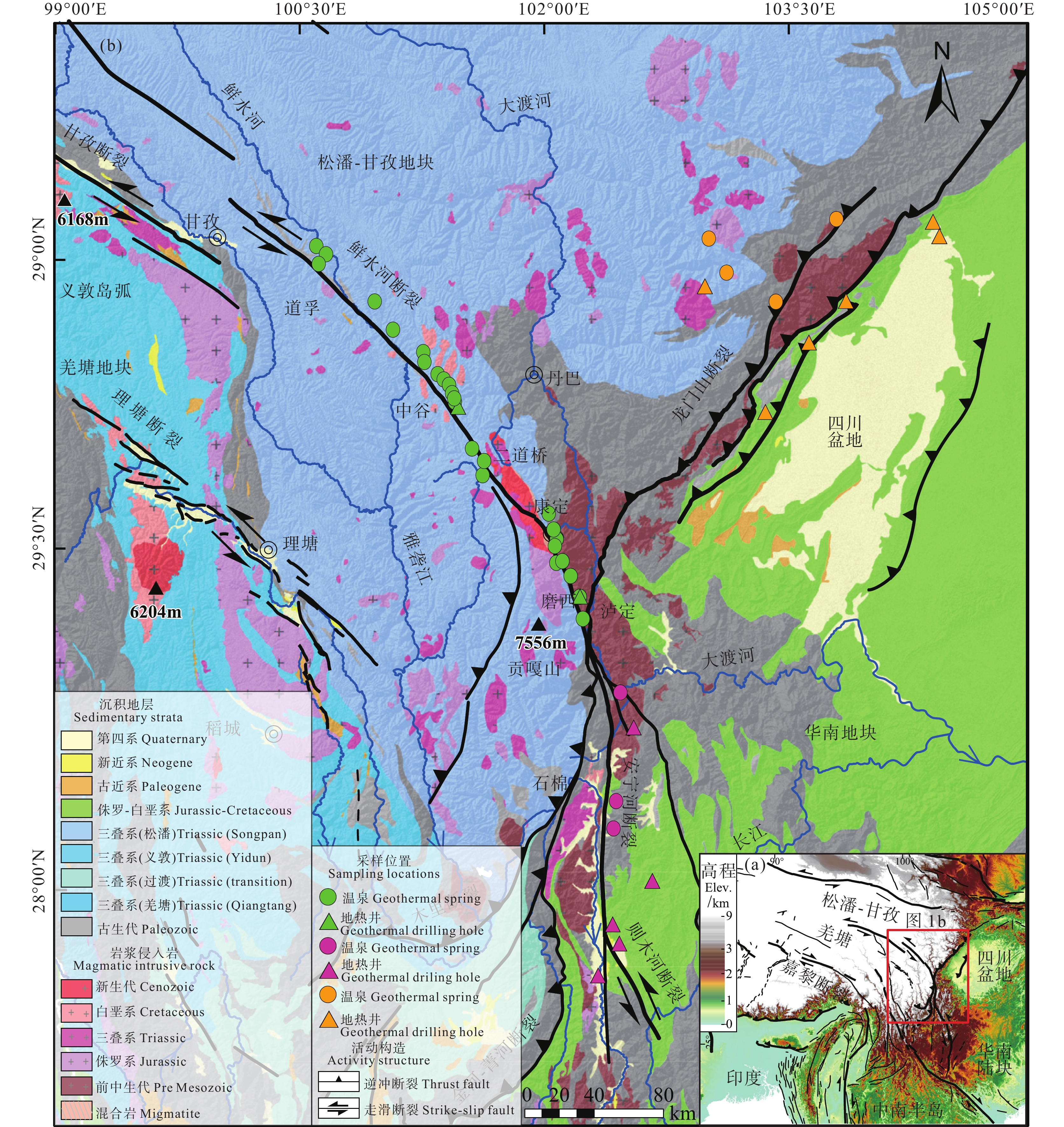
 下载:
下载:
